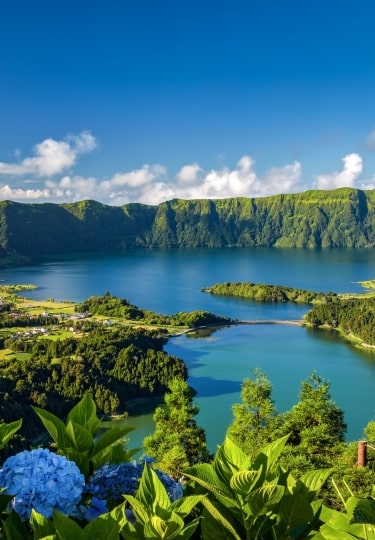From the mainland to the islands, the most beautiful places in Portugal range from wild coastal stretches to rugged mountain ranges, and medieval castles layered with history.
Continental Portugal has the hypnotic terraces of the Douro Valley and nearby Porto, with its hilly, coastal charm. Lisbon has its 16th-century Belém Tower and the Gothic Jerónimos Monastery, collectively winning UNESCO World Heritage status in 1983. And the Azores is filled with awe-inspiring natural wonders you won’t find anywhere else.
Discover the 11 most beautiful places in Portugal.
Belém Tower, Lisbon

Belém Tower, Lisbon
Belém Tower, built in honor of Portugal’s Patron Saint, St. Vincent, in lively Restelo, has been the crowning glory of Lisbon’s waterfront since its completion in the early 1500s. The attractive bastion stands on an island off the shore, guarding the Tagus River.
Designed by architect Francisco de Arruda, the 100ft-high tower features cupola-topped watch posts and ornate balconies, with Moorish and Portuguese late Gothic influences.

Belém Tower, Lisbon
Marvel at views of the Tagus River, including the 25th April Bridge, from the rooftop terrace (reached by a narrow spiral staircase). Browse the multiple spaces inside, from the Governor’s Room to the Kings’ Room, and don’t miss the Chapel, with its impressive vaulted ceiling.
Sete Cidades, Azores
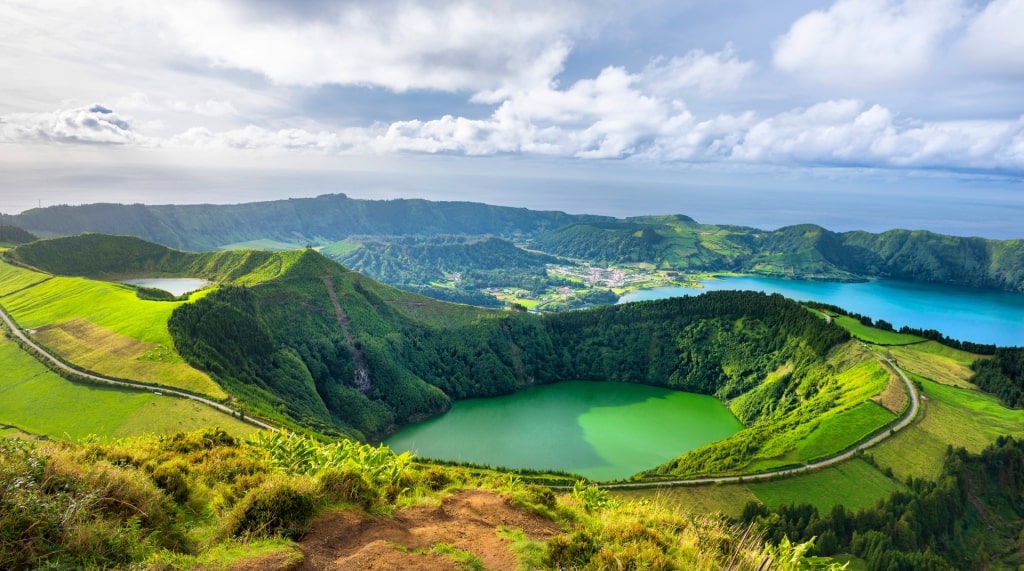
Sete Cidades, Azores
Sitting in the remote west of São Miguel Island, the largest of the Azores, Sete Cidades is a hulking, forest-covered volcanic crater filled with two spectacular lakes: Green Lake and Blue Lake.
Among the pretty flora to look out for on the journey from Ponta Delgada, São Miguel’s capital, are lilac hydrangeas, vibrant marigolds, and lemon trees, which bloom across the island from late spring.
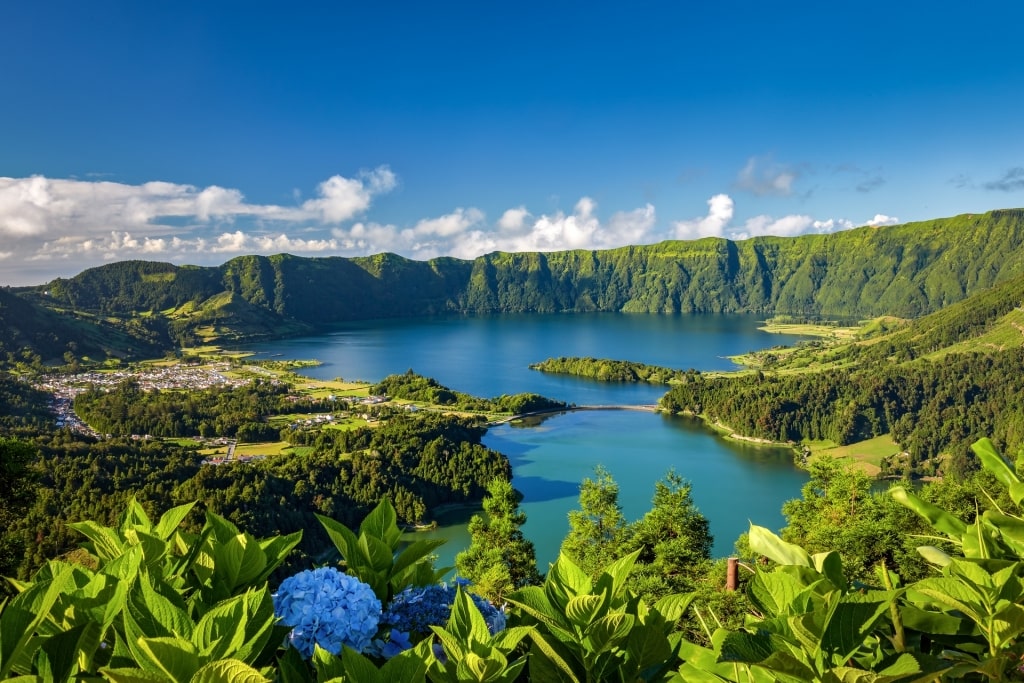
Sete Cidades, Azores
One of the best things to do in the Azores is to enjoy a hike around Sete Cidades. Make your way to Vista do Rei (King’s View) to the south of the Green Lake for a dramatic perspective.
On a clear day, you’ll also see the island’s rugged coastline and the vast Atlantic Ocean. You could also hire kayaks, stand-up paddleboards, and life vests to head out on the lakes for an invigorating paddle.
The Azores enjoy warm weather year-round, but mist and drizzle can roll in from the Atlantic Ocean with little warning. Pack a light raincoat and bring sunscreen to cover all weather.
Jerónimos Monastery, Lisbon

Jerónimos Monastery, Lisbon
The gleaming Jerónimos Monastery is one of the most beautiful places in Portugal. Very close to Belém Tower, the monastery was built in 1502 by order of Portugal’s King Manuel I, during the period known as the Age of Discovery.
Standing on the site of a former hermitage where Vasco da Gama spent his final night before setting sail for India, Jerónimos Monastery was built to honor the famous 14th- and 15th-century explorer.

Jerónimos Monastery, Lisbon
On a tour of the monastery, admire Vasco da Gama’s tomb inside the entrance, next to the tomb of poet Luis de Camões. Learn about the monastery’s significance as the former home of Catholic monks of the Order of Saint Jerome, whose role was to offer prayer and guidance to sailors leaving Lisbon for far-flung shores.
This Manueline-style monastery features beautiful cloisters with intricate sculptural details and nautical motifs of sea monsters, coils of nautical rope, and coral.
On the exterior, pay particular attention to the striking two-story South Portal with its rich design of gables and carved figures centered around a statue of Henry the Navigator.

Jerónimos Monastery, Lisbon
In 1940, an elegant garden was created featuring a topiary in the shape of various Portuguese municipal coats of arms, deep-green cypress trees, and a large central fountain.
Stop by the Thai Pavilion, located in the gardens, which was a gift from Thailand in 2011 to mark the 500th anniversary of the Portuguese arrival in Thailand.
Madeira Botanical Gardens, Funchal
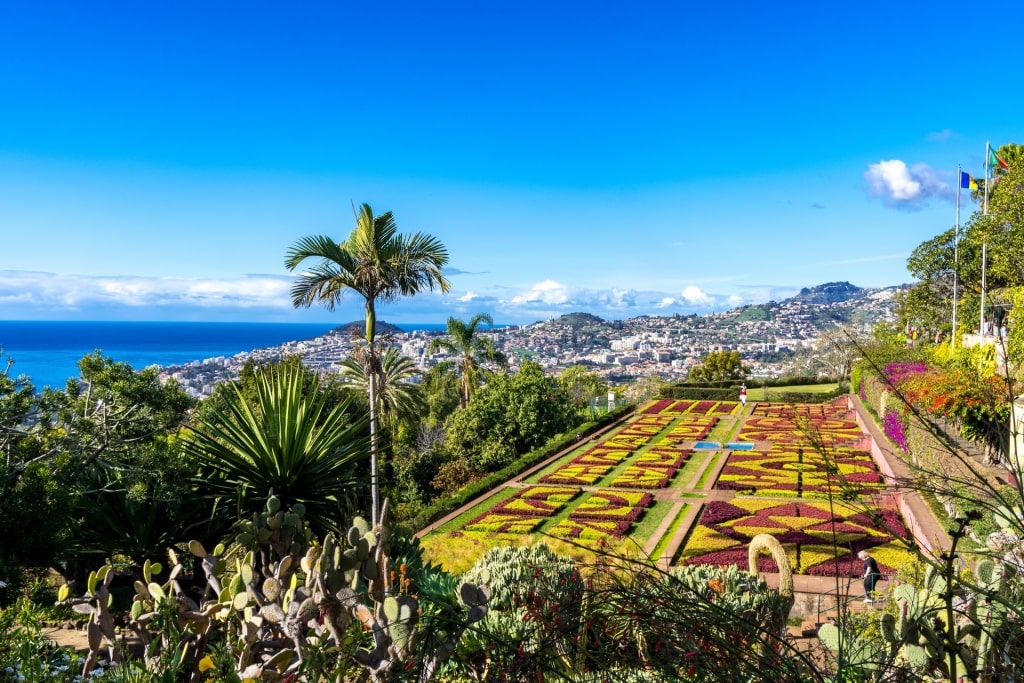
Madeira Botanical Gardens, Funchal
Madeira Botanical Gardens, in the island’s capital, Funchal, is celebrated as one of the most beautiful places in Portugal for its patchwork of plants. Founded in 1960, the gardens enjoy an elevated position, with visitors enjoying some of the best views of the city and the Atlantic Ocean.
The island’s lush and fertile soil is a haven for native plant species, with an entire area dedicated to indigenous and endemic plants from Madeira, the Azores, Canaries, and Cape Verde.
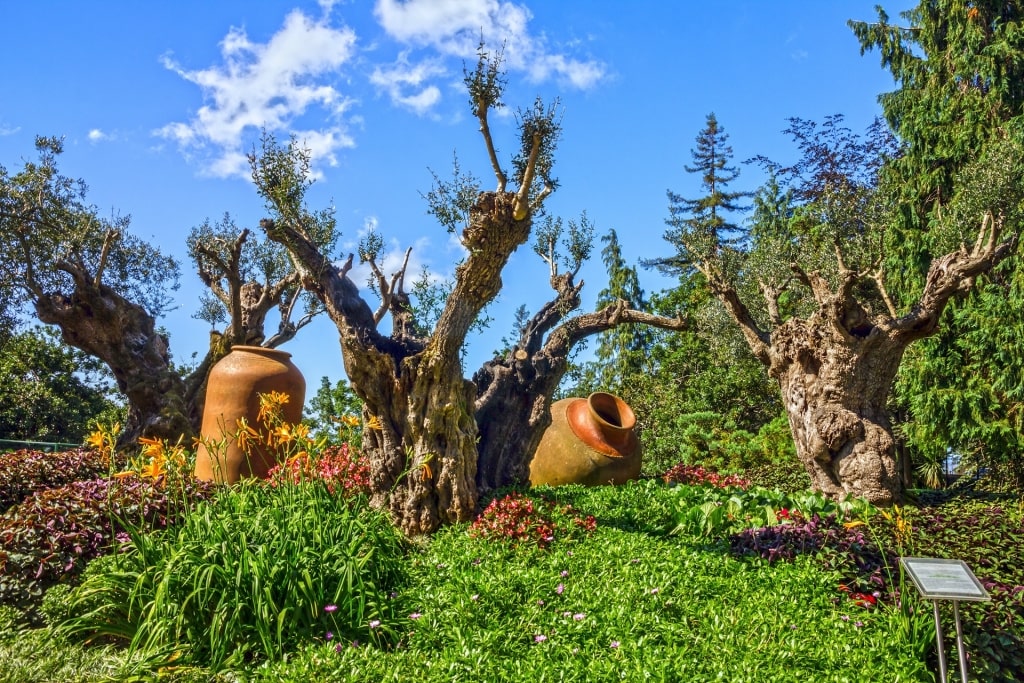
Madeira Botanical Gardens, Funchal
Other sections include The Tree Garden, filled with a range of trees from opposite ends of the world. The Succulents section specializes in fleshy and often peculiar-looking plants originating mainly from South America.
Take in subtropical fruit trees, coffee trees, and popular medicinal plants in the Tropical and Medicinal areas. In Loiro Park, you can watch a colorful array of feathery exotic and rare birds, from Australian parakeets and dwarf parrots to cockatoos.
Also here is Madeira’s Natural History Museum, with a focus on the island’s botany, fossils, coral, and fascinating stuffed animals.
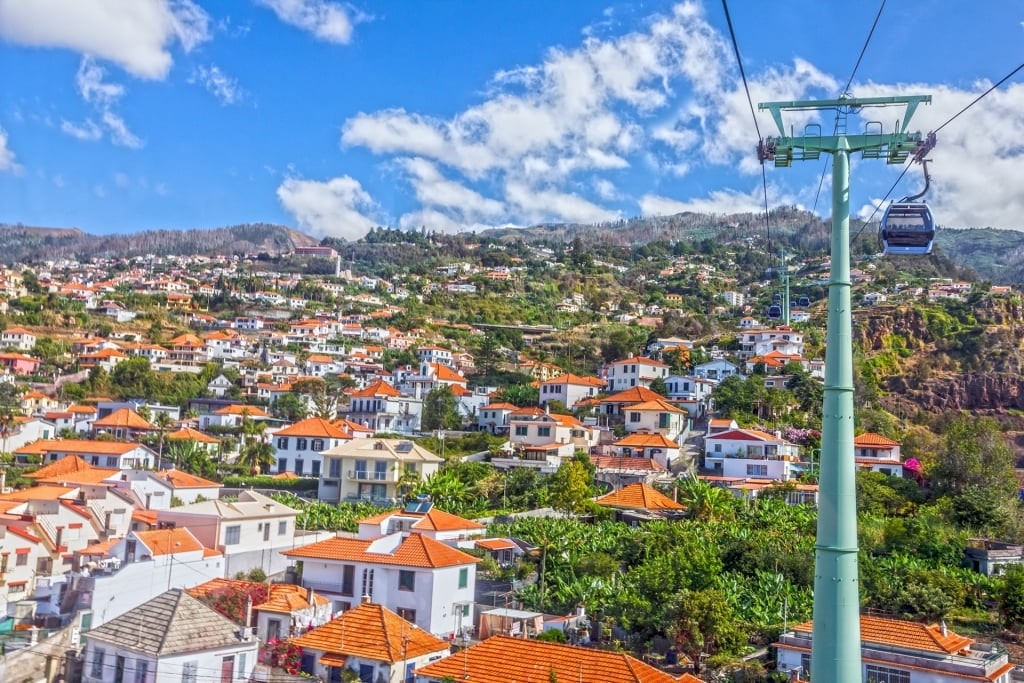
Madeira
After you visit the Botanical Gardens, one of the best things to do in Madeira is to take the cable car to Monte, ensuring your camera is charged to capture the experience. This nine-minute, one-mile route is the opportunity to soak up more of Madeira’s luscious landscape as the cable car traces the Ribeira de João Gomes.
Peneda-Gerês National Park, Porto

Peneda-Gerês National Park, Porto
In the far northeast of Portugal, just over an hour’s drive from Porto, is a mountainous home to the Iberian wolf: Peneda-Gerês National Park. The sprawling park is in the provinces of Minho and Trás-os-Montes, where you’ll find dozens of ancient villages in which time has seemingly stood still.
For travelers looking to experience nature, a visit is one of the best things to do in Portugal. Cows, goats, and sheep graze freely in meadows to a cacophony of birdsong. Wild boars, badgers, otters, deers, pine martens, and horses roam among the forested areas.

Peneda-Gerês National Park, Porto
Breathe in the fresh mountain air on a guided hike to witness the wild landscapes of one of the most beautiful places in Portugal. Peneda-Gerês National Park has serene waterfalls and an abundance of colorful vegetation, including the native violet Gerês lily flowers.
There are rivers and rapids, too, making Peneda-Gerês National Park perfect for canoeing and kayaking. Remember to pack sturdy walking boots and take a picnic along to enjoy Portugal’s only national park.
Monserrate Palace, near Sintra
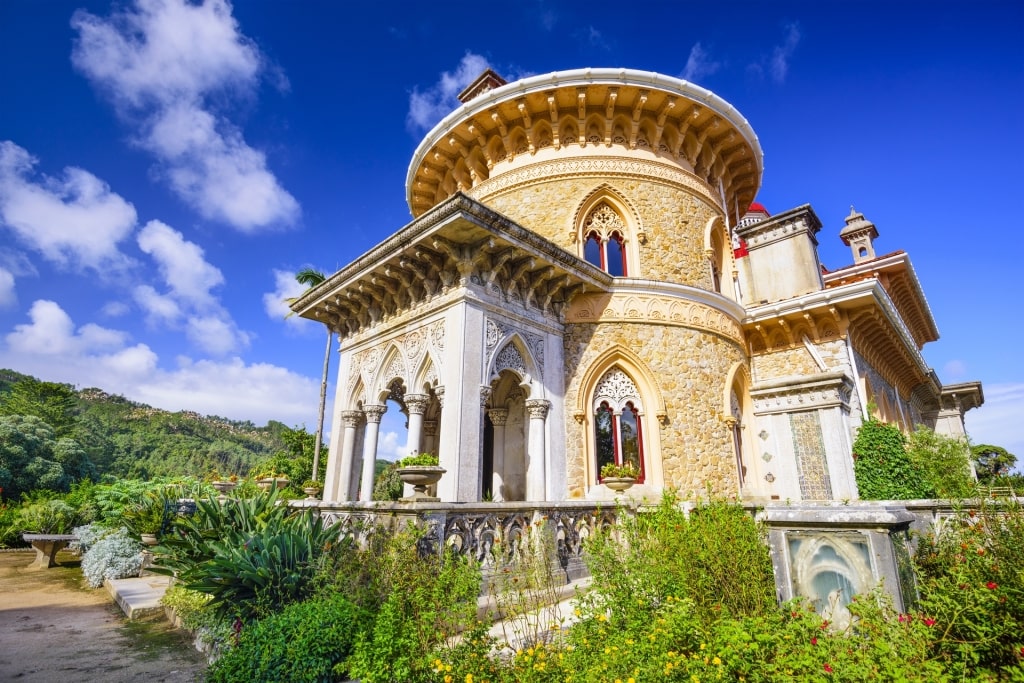
Monserrate Palace, near Sintra
On the grassy slopes of Sintra-Cascais Natural Park, an easy day trip from Lisbon, Monserrate Palace is one of the prettiest places in Portugal. Inspired by its spine-tingling beauty, the region has been a popular retreat for writers and intellectuals for centuries.
Chapels and other buildings have stood here since the 1500s, though the current building is much more recent. In 1846, British merchant and art collector Francis Cook bought the Estate of Monserrate. Some years later he commissioned prominent architect Sir James Knowles to create a summer residence for his family.
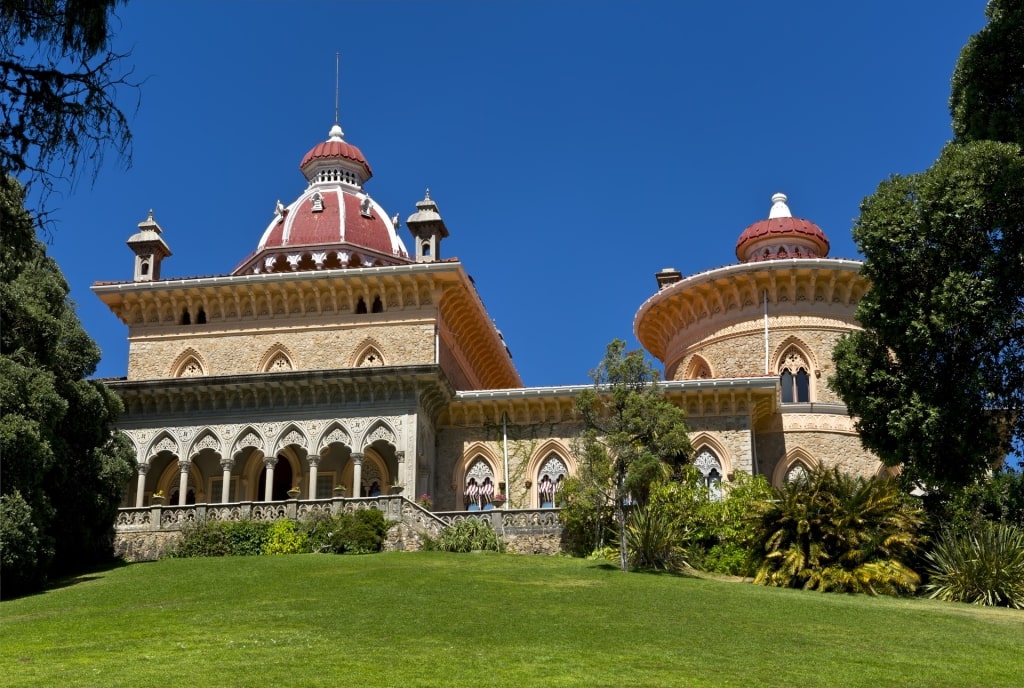
Monserrate Palace, near Sintra
Monserrate Palace features a mixture of Romanticism, Moorish Revival, and Neo-Gothic architecture—all fully restored in a renovation project that only ended in 2016.
Wander the leafy Garden Entrance, with its thick, stone columns. Gaze up at the octagonal domed ceiling of the Main Hall.
Admire the colorful stained-glass windows of the Sacred Art Room and, in the Gallery, witness the extraordinary succession of arches, finished in a lattice-style Moorish design. Look out for Renaissance artwork that has been added to the palace since its 2016 restoration.
25th April Bridge, Lisbon
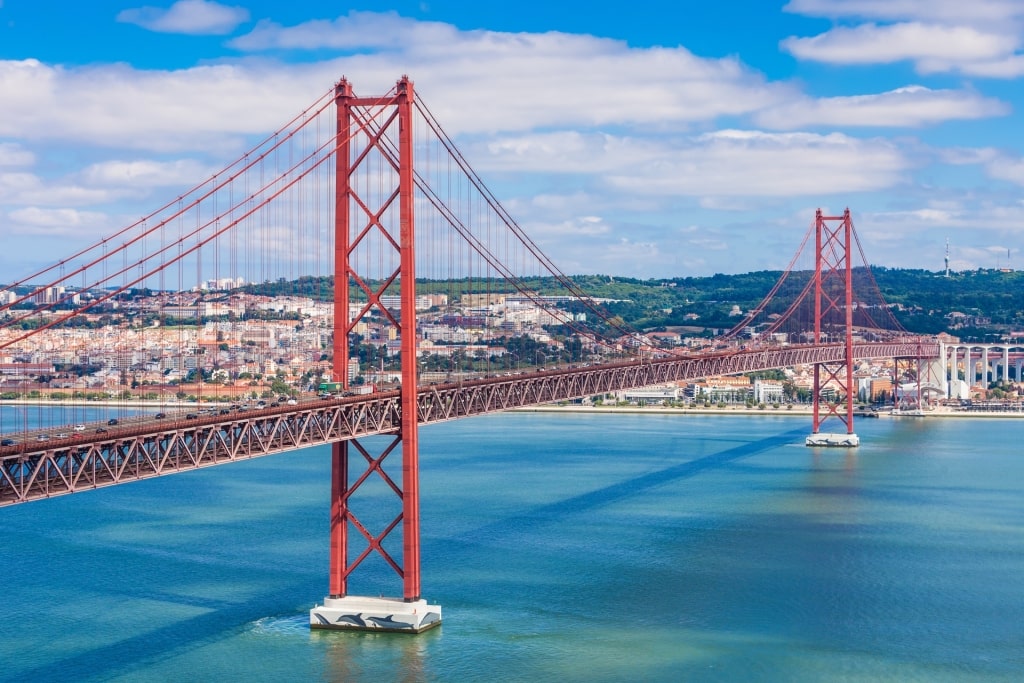
25th April Bridge, Lisbon
Almost identical to the Golden Gate Bridge in San Francisco, Lisbon’s 25th April suspension bridge crosses the narrowest part of the Tagus River. The bridge was originally named after Salazar, the former dictator of Portugal, but it was renamed after the revolution of April 25, 1974.
Although the bridge resembles the Golden Gate Bridge, and is painted in the same distinctive orange color, it actually shares an architect with San Francisco’s Oakland Bay Bridge.
Explore Pilar 7, the museum and observation viewing point on the northern side of the river, to learn about the bridge’s fascinating history. You’ll find a cluster of bars and restaurants on Av. Brasília in the marina next to the bridge. With views of the 25th April Bridge, it’s a lovely spot to enjoy a seafood lunch.
The Douro Valley, Porto
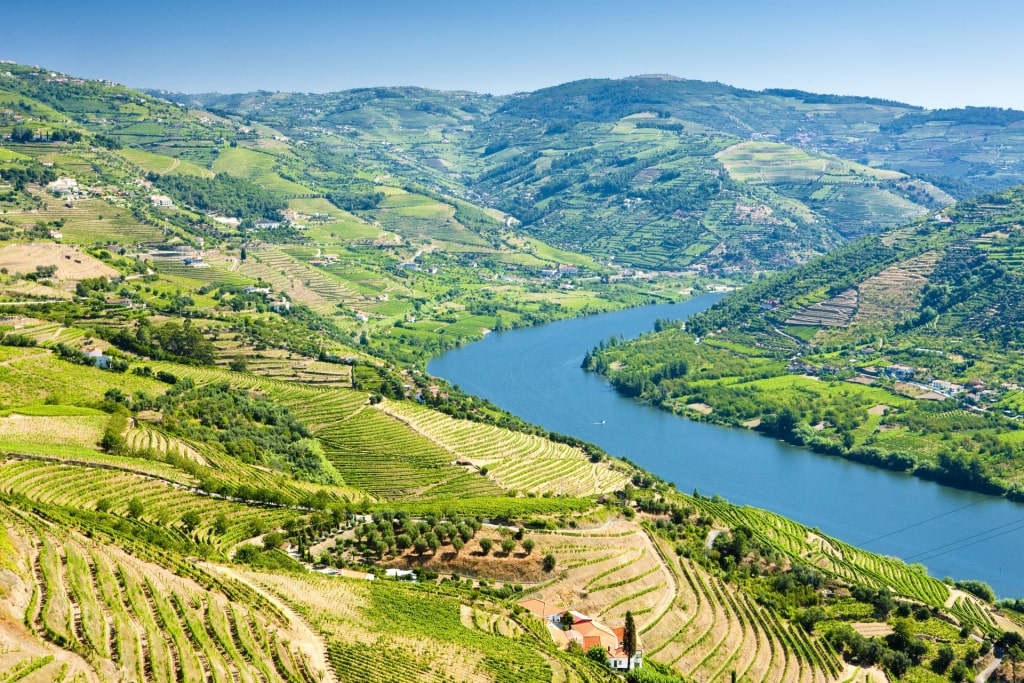
The Douro Valley, Porto
Set around the snaking Douro River, which stretches from Porto across the entire breadth of Portugal, northern Portugal’s prestigious wine region isn’t just popular with oenophiles. The gorgeous countryside is filled with sleepy pastoral scenes, making way for quaint towns, such as Peso da Régua and Pinhão in the Cima Corgo section of the river.
The vine-covered terraces that rise above the river produce outstanding wines and the port that Portugal is famous for. One of the best things to do in the Douro Valley is to embark on a wine-tasting tour of the local quintas (wineries).

Wine tasting in Porto
A wonderful tribute to the region’s centuries-old wine industry is the Douro Museum in Régua, which charts the history of the rich reds, mellow whites, and full-bodied ports.
Delve into the permanent exhibition, “Memory of the Wine Region”, before settling down to sample a delicious glass of port wine.
Porto Moniz Tidal Pools, Madeira
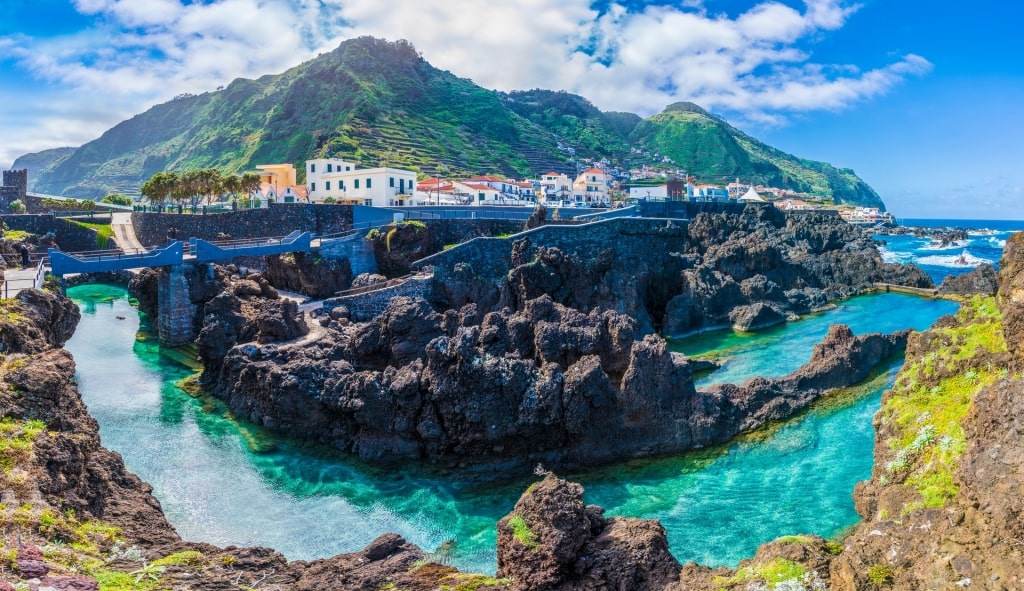
Porto Moniz Tidal Pools, Madeira
On the northwest coast of the remote island of Madeira, Porto Moniz is home to cliff-hugging tidal pools. North Atlantic breakers crash over the volcanic walls. It’s one of the prettiest places in Portugal, with bathing areas of sparkling azure water.
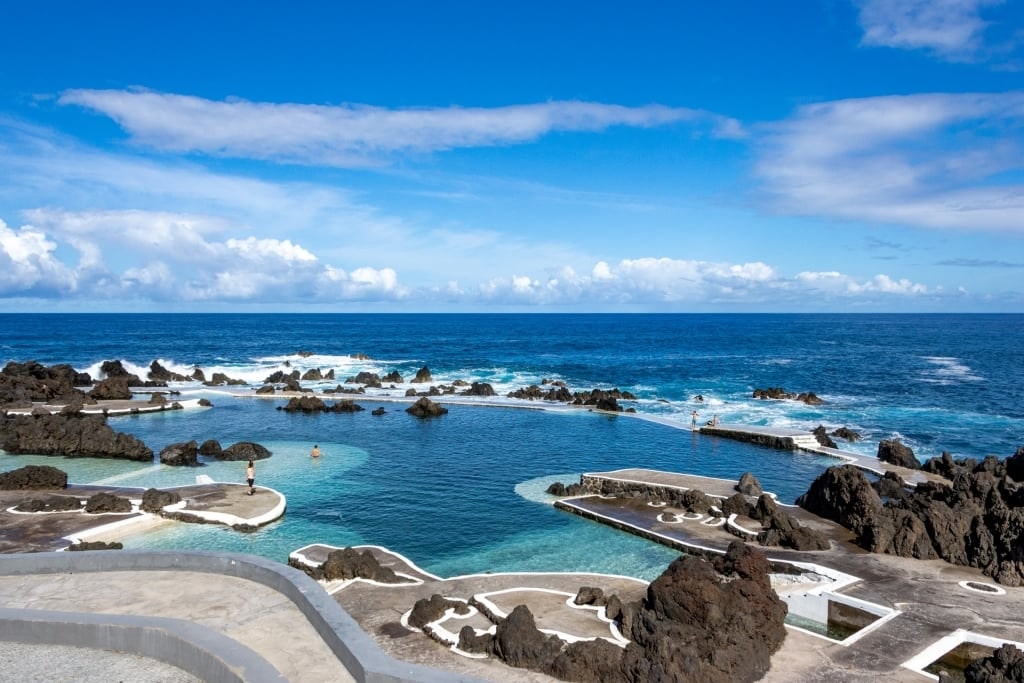
Porto Moniz Tidal Pools, Madeira
Swimwear, a towel, and sunblock are all essential items to bring with you. Changing rooms and bathroom facilities with lockers are available for storing your possessions while you cool off in the saltwater pools. There’s a children’s swimming pool, a children’s play area, and disabled access.
Once you’ve enjoyed an invigorating swim, dry off on one of the sun loungers. As one of the best beach towns in Portugal, Porto Moniz offers a superb view of the Atlantic.
Sea View Restaurant, next to the tidal pools, has an outdoor terrace and serves an inviting menu of fresh ocean shrimp, grilled limpets, a type of sea snail, smothered in garlic butter, and baked mussels.
Read: Best Beaches in Madeira
St. George’s Castle, Lisbon
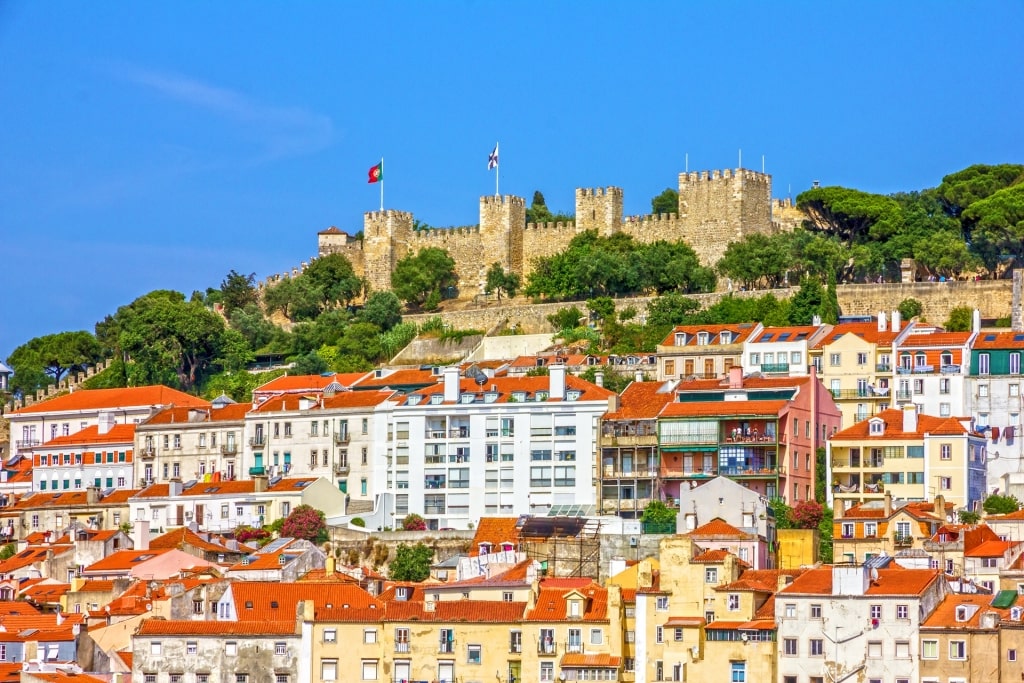
St. George’s Castle, Lisbon
One of the best places to visit in Portugal, Lisbon’s 11th-century St. George’s Castle is a splendid example of Moorish architecture, albeit restored after a major earthquake in 1755. Featuring 11 towers—the most notable being the Tower of Keep for its privileged orientation—the castle towers over the city’s sea of terracotta rooftops as a major landmark.
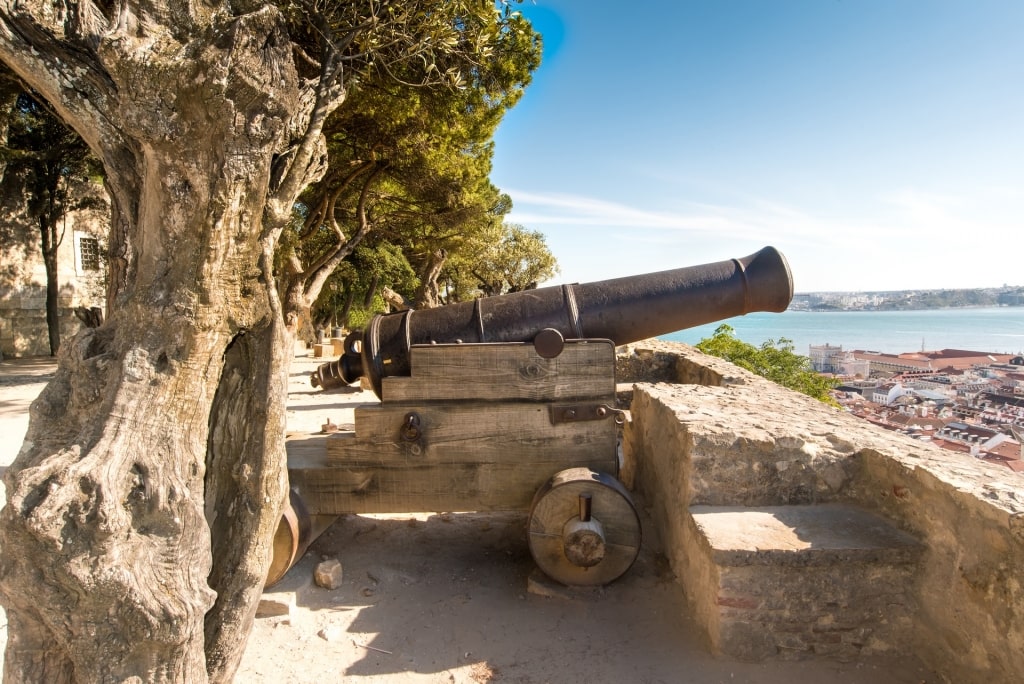
St. George’s Castle, Lisbon
There’s plenty to explore among the grounds of the moated St. George’s Castle, including the former royal palace, the remains of much older citadels, gardens filled with cork, olive, pine, and oak trees, and a large open square from where you can take in the views of Lisbon.
Take in the archaeological site at the medieval castle—offering evidence of the first known settlers in Lisbon—dating back to the 7th century B.C. The permanent exhibition traces Lisbon’s history, showcasing objects found within the archaeological site.
Once you’ve toured the grounds, treat yourself to one of Lisbon’s most famous dishes, pastel de nata, at the nearby Mercearia Castello.
Jardins do Palácio de Cristal, Porto

Jardins do Palácio de Cristal, Porto
Porto’s Jardins do Palácio de Cristal (Gardens of the Crystal Palace) is a serene space of manicured gardens and bubbling fountains with exquisite views of the Douro River.
This Porto attraction was designed by German landscaper Émile David to accompany the Palácio de Cristal building, which hosted the 1865 International Exhibition.
While the Palácio de Cristal building no longer stands, replaced with the domed Pavilhão Rosa Mota to host cultural and sporting events, the gardens are as gorgeous as ever and considered one of the prettiest places in Portugal.

Jardins do Palácio de Cristal, Porto
Stroll to the idyllic grounds to discover the sumptuous Émile David Garden at the main entrance, the fragrant Rose Garden, and the Garden of Feelings. You can steal glimpses of the Douro River from different viewing points, though one of the best is the central Miradouro da Ponte da Arrábida.

Ponte da Arrábida, Porto
The Palace Garden Turret, a stone lookout built into the perimeter, has more heart-stopping views, including of the Ponte da Arrábida arched bridge. Visiting here is one of the best things to do in Porto, where there’s an open-air theater, playground, cafe, and bathrooms.
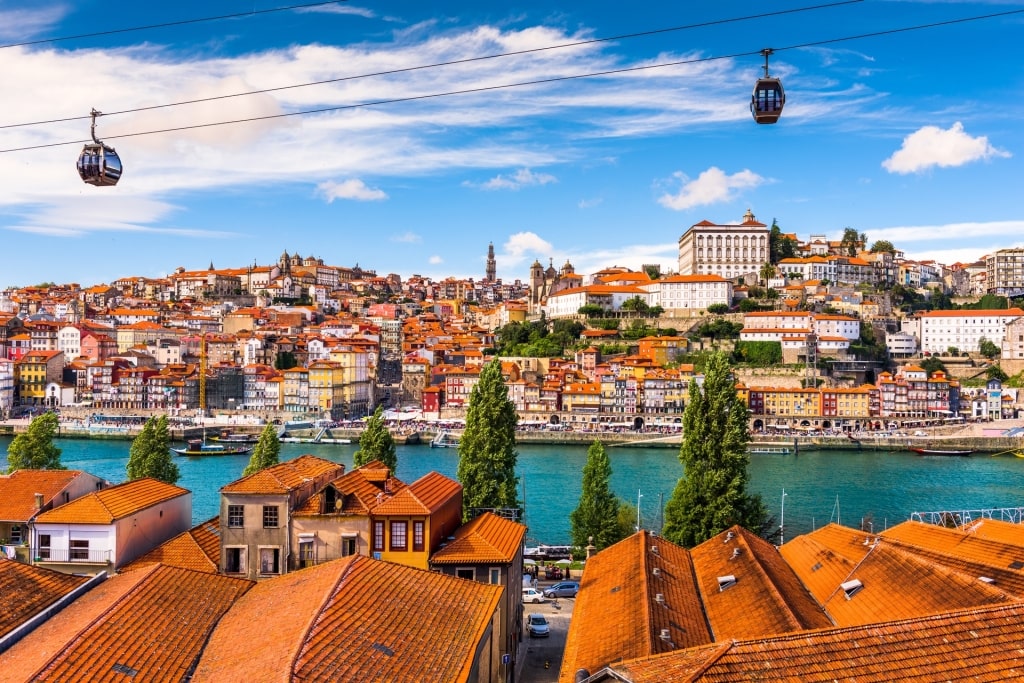
Lisbon
Tempted to explore the most beautiful places in Portugal? Then browse Celebrity Cruises’ selection of cruises to Portugal to find the perfect itinerary.
